Founded in 794 A.D. and modeled after the ancient Chinese city of Chang’an (today’s Xi’an), Kyoto was Japan’s imperial capital for more than 1,000 years until it was replaced by Tokyo in 1869.
The name Kyoto translates into “capital city,” fashioned after the Chinese for capital city (京都 pronounced kian to Hokkien, the ancient Tang language that Korean and Nihongo was based on). It is steeped not just in its own heritage and tradition, but has embraced modern technology and evolving culture as well.
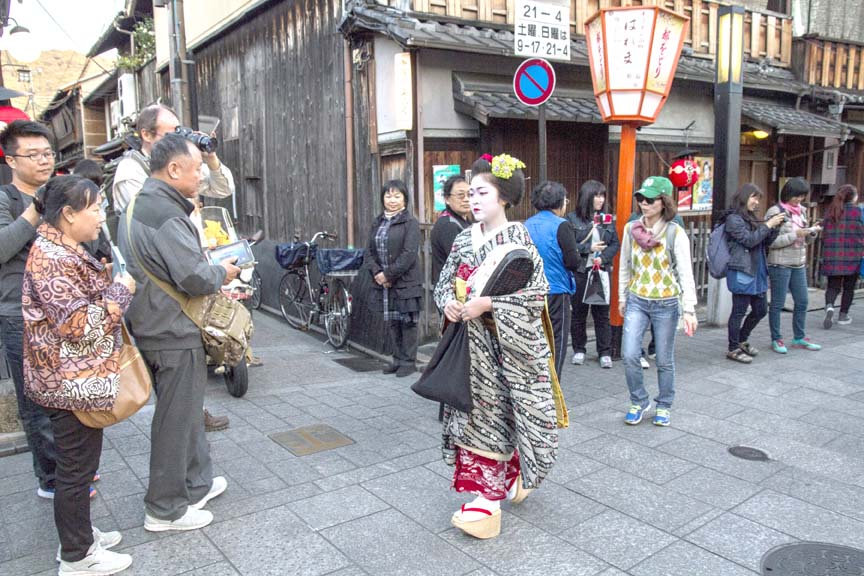
Kyoto is a rich blend of the old and the new. On the one hand, it is infused with formal traditions, imperial palaces and traditional wooden houses. It was once the center for Japan’s film industry.
On the other hand, it is home today to a futuristic train station as well as the first comprehensive center for Japanese manga (comics) in Japan.
Clearly Kyoto is adept in balancing the old and the new.
Arriving at Kyoto Station from Osaka, I stood in awe at the train station’s main lobby.
The early spring sunlight filtering through the glass ceiling lit up the futuristic cavernous grey stone interior. Exposed steel trusses support the plate glass roof, which towers 15 floors above the atrium.
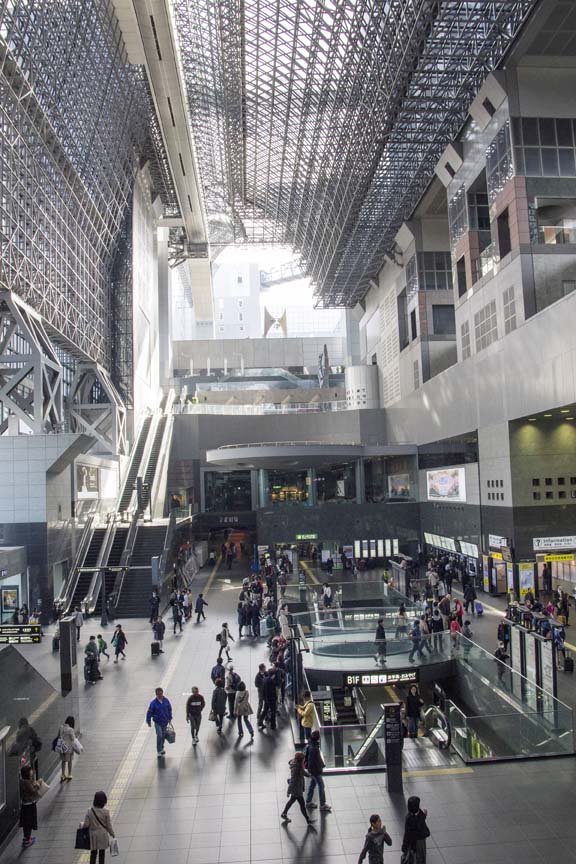
I read online that this station is said to be the second largest in Japan – it houses not only the train station, but has shopping malls, a hotel, a movie theater and several local government facilities.
However, when it first opened in 1997 to celebrate the city’s 1,200th anniversary, local residents were not sure what to make of its futuristic architecture. Today, the bustle in the station suggests people have embraced it.
They now come here to commute, attend to business, shop and dine as well.
The station’s architect, Hiroshi Hara, designed the space to allow air to flow through the building. It might have been a great idea for summer as it will naturally cool the building.
But in early spring, I felt positively chilly and sought shelter in a donut shop to plan my itinerary for the day.
I waited until 8:30 a.m. then left the donut shop for the Kyoto Tourist Information Center on the second floor, where friendly staffers helped me plan out my route and advised which buses to take.
From the tourist center I was also able to buy an all-day ¥500 bus pass that can be used on any bus line. My itinerary would include temples, an anime museum and a geisha district.
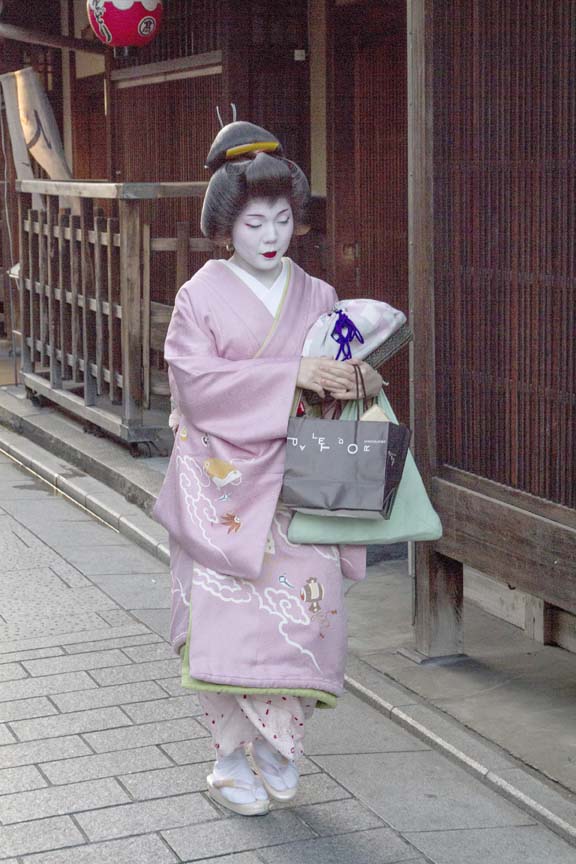
Kyoto is known for its temples. Referred to as “the city of ten thousand shrines,” it actually has only 1,600 Buddhist temples and 400 Shinto shrines. It is a lot to visit in one day, so I narrowed it down to two of the most famous: Kinkakuji and Kiyumizu-dera.
Largely spared from aerial bombing during World War II, Kyoto offers a wealth of heritage structures compared to other Japanese cities. It nearly became a target for the atomic bomb, but Henry Stimson, then the American Secretary of War, insisted on Nagasaki instead.
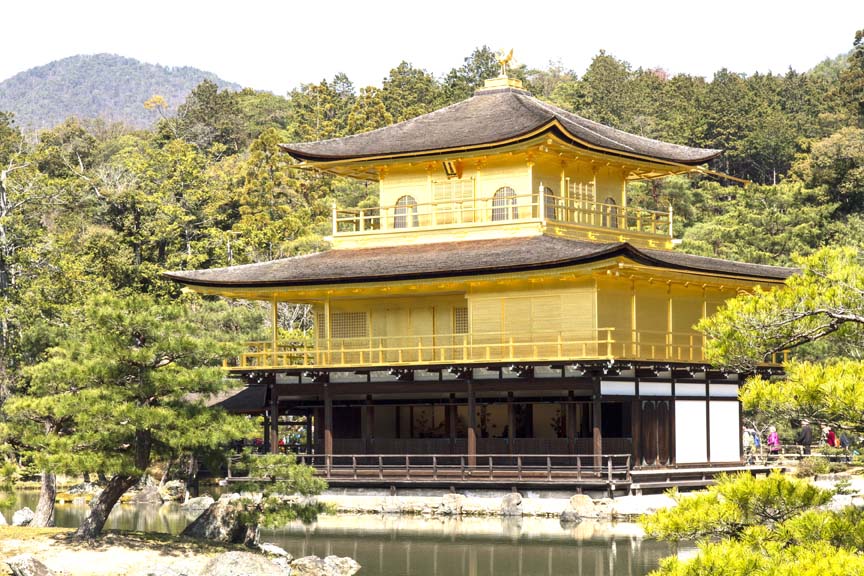
To round out my visit to Kyoto, I visited the Toei Kyoto Studio Park. There, an anime museum features some of the company’s most famous creations such as Sailor Moon and Mazinger Z. I also decided to visit Gion as well, Kyoto’s famous entertainment quarter.
My first destination for the day was the Kinkakuji Temple or “The Temple of the Golden Pavilion.” Formally known as Rokuon-ji, the highlight is a wooden pavilion covered in gold leaf.
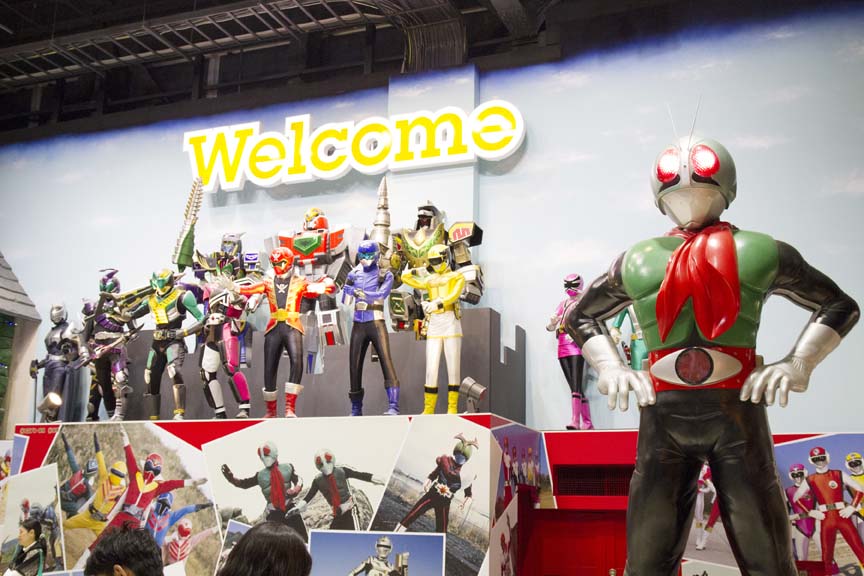
As if that was not dazzling enough, the pavilion is strategically placed near a pond which dramatically reflects how the view of the temple changes with the seasons.
Kinkakuji used to be a villa belonging to the shogun, Ashikaga Yoshimitsu. He bought it from the Saionji family in 1397 and made it his retirement home. After his death in 1408, he willed that the villa be converted into a Zen temple.
I have seen Kinkakuji many times before in magazines and posters. Viewing the actual structure did not disappoint. Although the design of the pavilion looks like it is unified, each floor of the structure is actually of different architectural styles.
While the complex dates back to earlier times, this pavilion is less than 100 years old. Kinkakuji was burned down and rebuilt several times. The most recent fire was in 1950 by a monk with a history of mental illness. It was rebuilt in 1955.
My next destination was the Kyoto Toei Studio Park. During the 1920s until the 1960s, the Toei Studio produced as many as 60 films in Kyoto. But when the demand for movies dropped, the studio decided to open part of its backlot to the public for tours. Since then, it has evolved into a theme park.
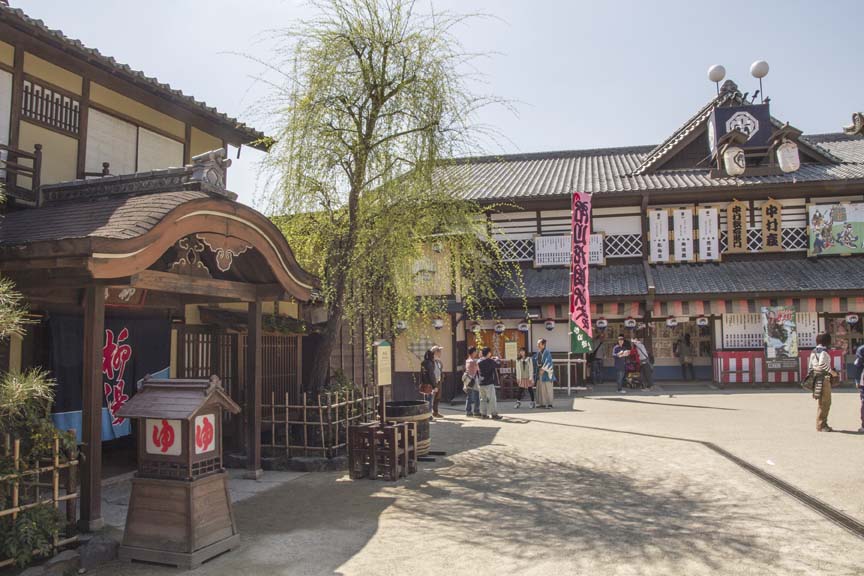
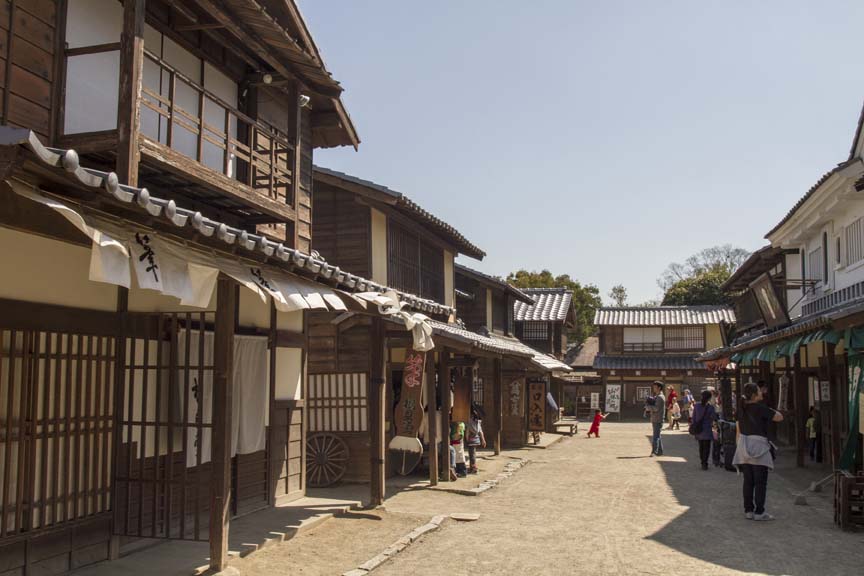
The studio used to film a lot of jidaigeki or samurai-period dramas. It features buildings from Japan’s Edo and Meiji periods (roughly between 1603-1912).
These include theater, police stations, farm house and even a red light district or yoshiwara. These are not merely façade as in some Hollywood studios. Some of the buildings feature interior sets as well.
The interior of one farm house, for example, was authentic down to the kamidana, a home altar placed high up on the wall.
Staff attendants are dressed in period costumes. Visitors can pay a fee and dress up in a costume as well. There are 30 characters to choose from including ninja, samurai and geisha.
While there are no rides at this park, there is a ninja trick house, a trick art museum, a 3-D theater and a live ninja stunt show. It is also said to have one of the scariest haunted houses in Japan. But the attraction that interested me more was the company’s animation studio.
All signs and description I could see were in Japanese. I suppose if you can read the language, you can learn more about how the company got into animation.
You can also have your photo taken with life size (or appropriately sized as in the case of the robots) recreations of your favorite anime character. Seeing some of them certainly brought back a lot of childhood memories. In the animation exhibit there is a section where visitors can try to create hand-drawn animation.
Visitors can also move on to a related exhibit that features costumed hero television shows such as Masked Kamen Rider Gaim and the Power Rangers. It features costumes and props from those shows, creating another photo-taking opportunity.
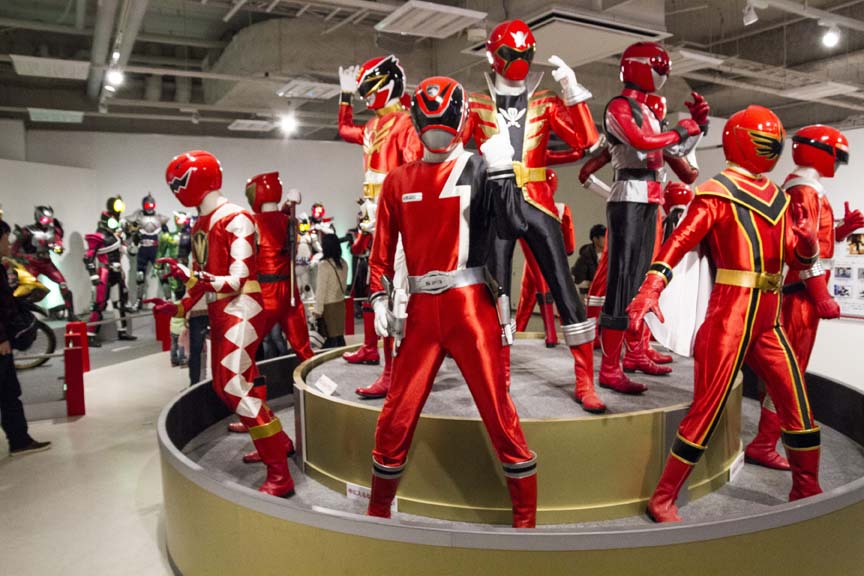
This theme park also pays homage to Kyoto’s cultural heritage. It features an art museum which has an exhibit dedicated to Japanese wood block printing or ukiyoe.
The prints on exhibit are not the original, but they do a good job of explaining how these classic prints are made. Interactive features make it more enjoyable and fun for kids as well.
By mid-afternoon, I moved from culture to urbanization. My goal was to explore Gion, famous for its geisha district and then visit Kiyumizu-dera temple afterwards.
From the bus, I saw people wearing the traditional Japanese kimono. At first I thought it was a sign of people’s reverence of their own tradition, until I got off the bus and walked past one group and heard some speaking in Cantonese.
Then I heard another couple speaking in Mandarin. It was then I realized that tourists were renting costume and playing dress up while exploring Kyoto!
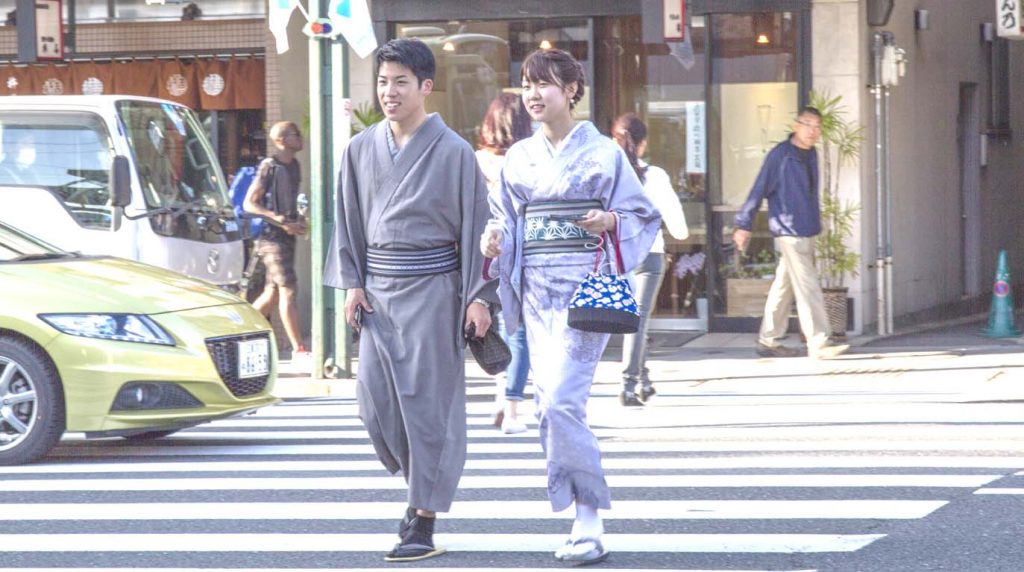
These tourists dressed up in kimonos really made me want to go to Gion.
Because if I spot a geisha outside of Gion, chances are it would be a tourist playing dress up.
If I wanted to photograph real geishas, I needed to do it in Gion as they report early evening for work in the ochayas (teahouses).
The CNN Travel website advised that those who want to photograph geishas should not stop or order them to pose or smile. There have been complaints about aggressive behavior by tourists.
When I arrived at Gion, I walked towards the Gion Shijo Bridge which overlooks the Kamo River. By now, the sun was setting and the sky was glowing in a multitude of colors. On the river, ducks and cranes were gathering and feeding.
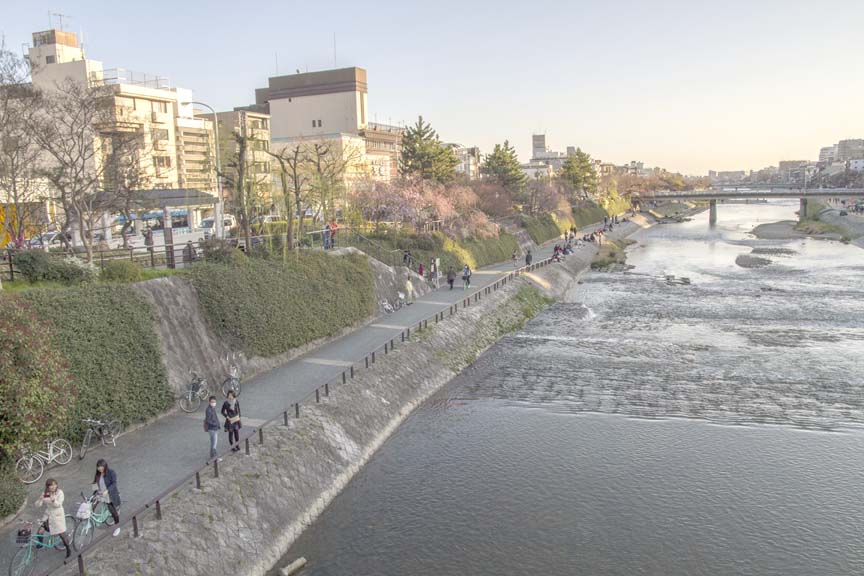
It was a scene of great beauty.
As it grew darker, I returned to Gion. By now tourists and photographers were gathering and waiting. It felt as if we were a group of wildlife photographers waiting for the appearance of a rare bird.
Then I heard a commotion and saw the first geisha walking toward us. My camera started clicking and I got some photos. But I was unsatisfied. Then I turned around and saw another geisha walking toward us. My camera clicked again and this time, I was satisfied that I got better photos. Having got what I came here for, it was time for me to go to my final stop for the day.
To reach Kiyumizu-dera I decided to take the scenic route and go via Ninen-Zaka and Sannen-Zaka. Both streets have stone-paved sloping roads lined with old wooden houses converted into teahouses, souvenir shops and restaurants.
The two streets lead to another sloped shopping street, Higashiyama, which leads directly to the temple. It was a not a difficult walk; I stopped occasionally to check out the shops and teahouses.
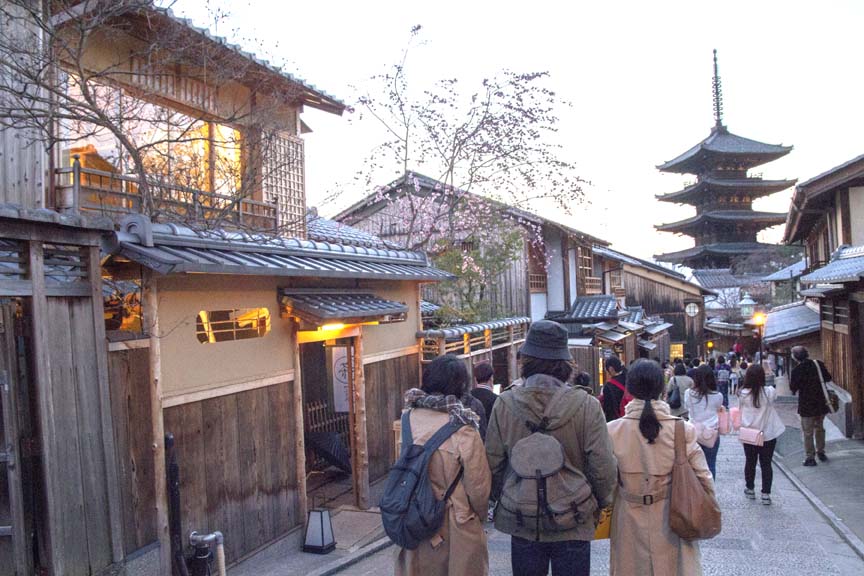
Kiyumizu-dera was built in 780 A.D. by the Hosso Buddhist sect. If you can read Chinese, you would recognize the characters for Kiyumizu-dera (清水寺) means “clear water.”
Within the temple grounds is the Otowa Waterfalls. Its pure waters are divided into three streams, each with a specific blessing. One is said to give you a long life, another good grades in school and the last a successful love life.
However, visitors are told to only drink one or two of the streams at a time, as drinking from all three streams in quick succession is considered greedy. I chose to visit this temple last because it is only at certain times of the year that the temple will be open until 9:30 p.m.
Since the temple is built on a hillside, it serves as a great vantage point to view Kyoto’s skyline at night. My timing was perfect. Even though it was transitioning to evening already, there was a band of the setting sun’s scarlet ribbon still visible in the horizon. It complemented the bright orange-red of the temple.
The only disappointment was that the main hall was enshrouded in scaffolding as it was undergoing repair work. But still seeing the grounds of the temple illuminated with the Kyoto’s skyline blinking in the distance was amazing.
I felt blessed. — First published in Tulay Fortnightly, Chinese-Filipino Digest 28, no. 3 (July 7-20, 2015): 14-16.





